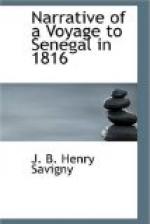The soil is in general good, and all colonists from the Antilles, who have visited these countries, think that they are well adapted to the cultivation of all kinds of colonial produce. This immense country is watered by the Senegal and the Gambia, which bound it to the north and south. The river Faleme crosses it in the eastern part, as well as many other less considerable rivers, which, flowing in different directions, water principally that part covered with mountains which is called the high country, or the country of Galam. All these little rivers fall at length into the two large ones, of which we have spoken above.
These countries are very thickly peopled, and are in general mild and hospitable. Their villages are so numerous, that it is almost impossible to go two leagues without meeting with some, that are very extensive and very populous. Nevertheless, we have no more than two settlements; those of St. Louis and Goree; the others, which were seven or eight in number, have been abandoned; either, because the French and the English, who have occupied them in turn, have wished to concentrate the trade in the two settlements which still exist; or because the natives no longer found the same advantage in bringing their goods and slaves. It is, however, true, (as we have been assured) that in consequence of the abolition of those factories, the considerable commerce which France carried on upon this coast before the revolution, has been reduced to one fourth of its former extent.[A14]
The town of St. Louis, the seat of the general government, is situated in longitude 18 deg. 48’ 15” and in latitude 16 deg. 4’ 10”. It is built on a little island formed by the river Senegal, and is only two leagues distant from the new bar formed by the inundation of 1812. Its situation in a military point of view, is pretty advantageous, and if art added something to nature, there is no doubt, but this town might be rendered almost impregnable; but in its present state, it can hardly be considered as any thing more than an open town, which four hundred resolute men, well commanded, might easily carry. At the mouth of the river is a bar, which is its strongest bulwark. It may even be said, that it would be impossible to pass it, if it were well guarded; but the coast of the point of Barbary, which separates the river from the sea is accessible; it would be even possible, without meeting with many obstacles, and with the help of flat bottomed boats, to land troops and artillery upon it. When this landing is once made, the place may be attacked on the side of the north, which is entirely destitute of fortifications. There is no doubt, but that, if it were attacked in this manner, it would be forced to surrender at the first summons. However, many have hitherto considered it as impregnable, believing that it was impossible to make a landing on the coast of Barbary. but as we are convinced of the contrary, because the English already executed this manoeuvre at the last capture of this place, we venture to call the attention of the government to the situation of St. Louis, which would certainly become impregnable if some new works were erected on different points.




